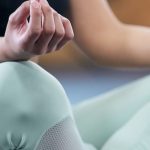An unavoidable fact of aging is that your bones get thinner. If you fail to combat this breakdown in bone tissue, you could find yourself on the road to osteoporosis and the associated fractures and breaks that come with it.
Regular strength training has been proven to increase muscle mass and improve balance. Balance is key as you get older – better balance means fewer falls and a reduced chance of bone injuries. In fact, regular exercise has been shown to reduce falls in older adults by one-third.
The types of exercise you should be aiming to do to build bone strength should include some, or all, of the following:
Resistance
By working out using resistance bands, weights or your own bodyweight, you will cause your muscles to contract, which pulls on the bones, strengthening them in the process.
Example: Wall squat
Method: Standing up, place your back against a wall. Walk your feet out about 18 to 24 inches. Place your hands on your hips. Slowly bend your knees and hips, sliding your back down the wall. Stop before your buttocks reach knee level. Hold. Slowly straighten your legs as you return to the starting position. Do 1-3 sets of 8-12 reps.
Weight bearing
Activities such as running, hiking, dancing, tennis or badminton help your body work against gravity. As your body works hard to counteract the effects of gravity, your bones grow stronger.
Example: Bench press
Method: Lie on your back on a bench with your knees bent and feet flat on the bench. Hold a weight in each hand by your chest, with your elbows bent and pointing out to your sides. Press your shoulder blades into the bench as you straighten your arms, raising the weights above your chest. Slowly return to the start position.
Impact
The higher the impact on the ground – ie longer stride or bigger jump – the more pronounced the strengthening effect, as it multiples the weight-bearing effect against gravity.
Velocity
Impact increases with speed, so the faster you go, the more advantageous it is for your bones.
Changes in direction
Studies have shown that people who take part in sports that involve rapid changes in direction, such as football, squash or badminton, have bone strength similar to those who take part in triple jump or long jump.
Example: Turning side step
Method: Stand up with feet together and your arms by your sides. Step with your right foot out to the side, turning your body and right toes to the right. Bend your arms and let them swing naturally. Then bring your left foot to the right and tap it next to your right foot. Step with your left foot and then your right foot back to the starting position, swinging your arms to complete one rep. Complete 3 sets of 8 reps on each side.
The International Osteoporosis Organisation recommends taking part in exercises that combine all of the above – so include high-impact aerobic activities alongside strength training for maximum benefits to your bones.



